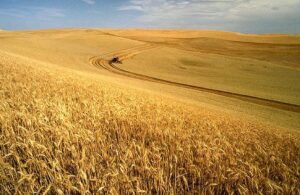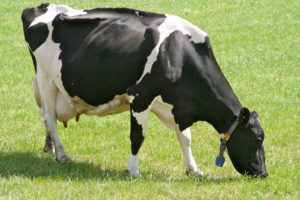What’s the first thing that comes to mind when I say, “Describe the year 2023 farm economy in one word?” Actually, I’m not sure one word would be adequate, especially if you live and work in rural America. The best way to describe 2023 in the agricultural community for many may be “Is it 2024 yet?”

Dave Widmar is an agricultural economist with Agricultural Economic Insights in West Lafayette, Indiana, and keeps a close eye on the ag economy. We had a conversation during the last National Association of Farm Broadcasting Annual Convention in Kansas City in November, a week before Thanksgiving.
“One of the biggest stories of 2023 is declining net farm income,” Widmar says as the crowd in the Trade Talk event walked by in the background. “That’s not a big shocker to most people in rural America, but we have to put it in perspective. It’s still historically high, so we need to bring it into balance.”
Unfortunately, that income balance doesn’t apply equally to all parts of farm country. He said the Midwest and the Corn Belt did especially well during the last three years combined. In fact, he called the last three years (2021-2023) the “best three-year run” since the 1940s.
“On the other side of the narrative, commodity prices have trended lower,” he said, “especially on corn. We also had another year of below trendline yields combined with higher interest rates.”
AEI isn’t necessarily watching the interest rates the general public hears about during the evening news. Those are the short-term rates the Fed adjusts at their meetings, and, since June, the Fed has raised short-term rates 25 basis points. “On the other hand, long-term rates have increased 150 basis points,” he said.
“That may continue into 2024 as that yield curve un-inverts as we move into a different economy next year,” Widmar said. “As the Fed spent time raising rates, the curve got inverted, meaning short-term interest rates got more expensive than long-term rates. This is often thought of as an indicator that recession may be coming.”

Now the Fed has paused interest rate hikes, the long-term interest rates have continued higher. That means the yield curve is starting to un-invert, something he’ll continue watching.
There is some good news for the economy. The unemployment rate remains low, which is a positive trend, and inflation has come down “significantly.” In his words, “the genie isn’t back in the bottle yet.” The country isn’t back to two percent inflation, and the last 150 basis points on inflation are going to be the hardest to reduce. “A lot of moving pieces in 2023,” he added.
So, what do those moving pieces possibly mean for 2024? For those looking for the economy to settle down, they may be disappointed. Widmar said “hold on.”
“The volatility is probably going to continue,” he said ruefully. “That isn’t all bad. Despite record fertilizer prices, the uncertainty around usage, demand, and inflation, the farm economy had a good run between 2011 and 2023.
“We could see some reversion to the mean,” Widmar added. “Farm incomes might be lower next year but not necessarily historically bad. What we need to realize is the last three years are not normal.”
The last three years weren’t typical in terms of government payments, commodity prices, or profitability. Widmar says it’s time to start recalibrating our expectations as to what’s normal and what we should plan on being normal in the future. Speaking of the future, what should producers be thinking about heading into next year?
“One of the big things we’re keeping an eye on is acreage distribution,” Widmar said. “There’s always at least some reallocation. One of the things that we observed in 2023 was that we had a lot of corn acres and not as many soybean acres. That’s resulted in an imbalance in ending stocks.”
That’s put corn ending stocks are above the long-run average, closer to 15 percent than the average of 13 percent. Soybeans are closer to five or six percent instead of the long-run average of eight.
“That means we may see some acreage reallocation,” Widmar said. “Producers should keep an eye on the relative price ratio and how that’s going to impact their budgets.
“They also need to keep an eye on fertilizer expenses,” he added. “Fertilizer has come down a lot recently, and that’s going to benefit corn budgets quite a bit.”
Another thing to watch for is farm debt. One of the things the economists at AEI have observed is new farm loans with different terms than in the past. Take a machinery loan, for example. The payment terms have been stretched out. How does that affect the bottom line?
“For every $1,000 of farm debt one takes on, the payments are going to be about the same as they were the last few years,” he said. “The payment hasn’t changed. What’s changed is the ‘stretching out,’ which means more payments get added to the backside. The extra interest expense is backloaded into the form of additional payments.”
Interest expenses are increasing as we go forward, and it will take more payments to maintain the same level of debt that farmers have had in the past. He said a lot of the economic challenges we face today may be getting “kicked down the road.” But there is one good sign amid some uncertainty looking to the new year and 2024 spring planting.
“Lenders are still confident and comfortable making long-term loans on things like machinery,” he said. “One of the big differences between the 1980s and today is back then, we had very high interest rates and short repayment periods. Some repayment periods lasted less than a single year.”
That created a large problem of no access to capital in the ‘80s. Today, Widmar said there’s a lot of available access to debt markets, which are very accommodating right now. But, he says, just because someone will lend to you at those terms doesn’t mean you as a farmer need to accept them. “Always be thinking about the implications of any loan terms you accept,” he added.
“Stretching the terms out has kept the payments low, but now that we’re in a high-interest environment, how are producers going to adjust,” he asked. If costs like fertilizer, electricity, or gasoline go up, Economics 101 teaches that we should be using less of each input.

“What do we do then with the higher cost of money,” he said. “Using less of an input is one particular approach. We can also shift the way we’re using money, including using more long-term debt last year and then shift it to short-term debt going forward. We always have to be evaluating how we’re using debt.”
In closing, he pointed out that agriculture hasn’t been in many rising interest rate environments in the past. The 1980s was one, and farmers and now in another. Producers need to revisit the strategies they’ve been deploying around farm finances, the use of farm debt, and their cash flow.





